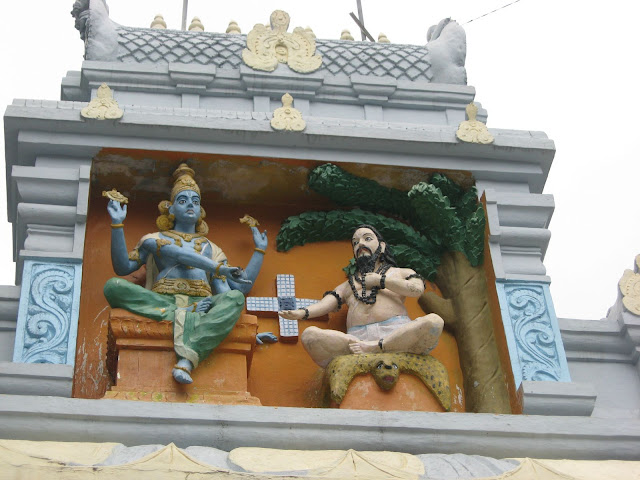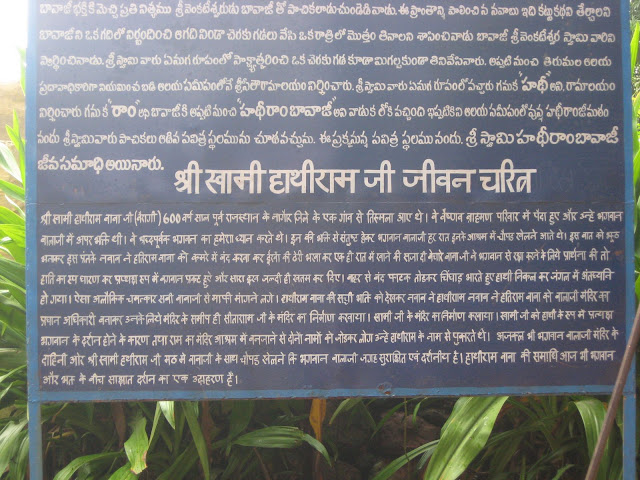As the story goes, a long, long time ago, a holy man from Nagaur in Rajasthan came to Tirupati. One sight of the Lord was enough to make him an ardent devotee of the Lord and he decided to stay on, setting up an ashram right outside the temple. Well, his devotion to the Lord was so complete, and so real, that the Lord himself came to play dice with him every night! One night, the game continued longer than usual, and the Lord suddenly realized that the temple would open soon, and he hurried away, leaving behind one of his necklaces in a hurry. As soon as the doors of the temple opened, the priests noticed the missing necklace, and instituted a search. Meanwhile, the sage too realized that the Lord had left his ornament behind, and he rushed to the temple to return it. He was caught at the door with the necklace in his hands, and was immediately condemned as a criminal. He was confined to house arrest while the matter was taken to the king. Some accounts refer to the king as Krishnadevaraya, while others refer to a Nawab, so there is no confirmation. Anyway, the king must have had his doubts, for he ordered that the sage’s room be filled with sugarcane, and deemed that the sage eat every bit of it before morning if he wanted the king to believe his story! The mound of sugarcane was too huge for him to even contemplate eating, and he instead prayed to the Lord for deliverance. In the darkness of the night, there suddenly appeared in the room, a huge white elephant, with sandal marks on his forehead, who chomped on the sugarcane, finished it in a matter of moments, and then bellowed and charged his way of the house, startling everyone around! No one could imagine how an elephant could enter the house, let alone get inside the room without any of the guards being alerted, and the king was forced to concede that the Lord had indeed appeared himself, to vouch for his devotee. Thus was the sage vindicated, and henceforth, he was called ‘Hathiram Baba’ – Hathi for elephant, and Ram for the name of Rama which he uttered at all times! It is said that the temple accounts were turned over to him, and it is he who is responsible for the financial system followed for a long time at the temple. Again, I was unable to find any corroboration for this. However, it is a fact that the mahants belonging to the Hathiram Baba Math were responsible for the management of the temple from 1843 to 1933, when the TTD was formed and the administration handed over.
The Hathiram Baba math still stands at its original location, right outside the temple. If you stand outside the temple, facing it, on your left, you can see some old houses at a raised level. These are all part of the Math, and include, apart from the original house, some temples, accommodation for pilgrims, and even a marriage hall! You can approach this area through steps on the left of the temple, behind a huge board announcing the various sevas that can be performed at the temple.

The ancient house is just that – maintained almost as it must have been once upon a time. There is a small shrine to Lord Rama, the same idols brought here by Hathiramji. There is also a shrine to the Dashavatars – the ten incarnations of Lord Vishnu. However, the most interesting thing here are the thousand shaligrams worshipped by Hathiramji. Shaligrams or Saligrams are stones found in the river Gandaki. These are considered sacred, and believed to represent Lord Vishnu. According to Wikipedia,
“The Shilas ( Ammonite fossils) are worshipped as manifestations of Vishnu Himself, identifiable from other stones by special markings, believed to resemble Vishnu’s paraphernalia such as mace, conch, lotus and disc(Chakra). Narasimhadeva, varahadeva and Vamanadeva are popular forms of worship. They are either black, red, or mixed in colour and are usually kept closed in a box and are only brought out for daily worship (puja). The Shilas are usually hereditary and are passed down through many generations, never being purchased or sold.”
There are a thousand such small stones, most of them black, in the Hathiramji Math at Tirumala, and is the main attraction for pilgrims. That these are fossils is clear to anyone, but it also seems quite natural that they are likened to the conch, discus, etc. in an attempt to preserve them! Unfortunately, this attempt at preservation only succeeds in keeping such interesting relics under lock and key, untouched by anyone!
The most interesting thing in the ashram, at least to me, was the presence of some old paintings of the Lord playing dice with Hathiramji. The museum had a copy, and mentioned that the oldest such painting was at the ashram, which is what pushed me to make a visit! Replicas of this scene are all over Tirumala, but I had never noticed them before…. There is one right near the entrance to the temple too…next to the Seva board I told you about, earlier. Here is one such at the temple of Venugopalaswamy…..
The temple of Venugopalaswamy, a form of Lord Krishna, is another place of interest related to Hathiram Baba. This temple enshrines a marble idol of Krishna with a flute, standing next to a cow – an idol consecrated by Hathiram Baba, or so the story goes.
Here are the boards which give information about this temple. Unfortunately, all these boards are in Hindi, but for those you who can’t read it, it only says what I have already mentioned about the saint.
More interesting is the fact that his Samadhi, believed to be his Jeeva Samadhi (which means that he is believed to be alive, but deep in meditation in his self imposed tomb) lies at the same place. This was a fact I was unaware of, otherwise I would surely have taken more photos of the place. As it is, the most interesting thing in the place turned out to be the shops selling wooden articles, and we had a wonderful time going through them. However, the shopkeepers were wise to tourists, so the prices were rather steep and we restricted ourselves to window shopping! The darkening rain clouds encouraged us to move, and we hurried on…..
Location: Venugoplaswamy temple is located on the route to Papavinsam. Buses are available at regular intervals from Tirumala. This can also be combined with a visit to Papavinasam, and Akasaganga. A jeep to these three places costs about Rs.50 per person, or Rs. 300 for the full jeep. Hiring a jeep for visiting all the places on Tirumala costs about Rs.500
Courtesy : http://anushankarn.blogspot.in/2010/12/tirupati-part-7-hathiramji-and-his.html/


